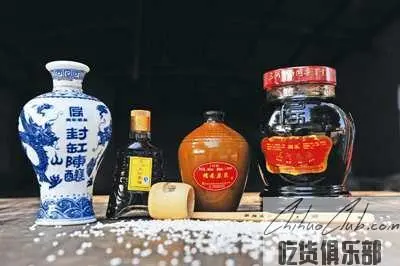
Sanhe Rice wine
-
Update date::
-
Date of protection::
-
Protected range:Sanhe Rice Wine is produced in the administrative area of Sanhe Town, Feixi County, Anhui Province.
-
Related origin:
-
Category:
The history of the production of glutinous rice liqueurs in Sanhe is very long. In the early years, there was a kind of liqueur called Jinbo, which had a great influence on the local area. After the founding of the People's Republic of China, Sanhe Winery organized its technical strength in 1951, excavated the essence of folk crafts, and began to produce glutinous rice-sealed wine, which was called Chaohu liqueur. This wine is made from the superior glutinous rice on the shore of Chaohu Lake. It is made by artificial traditional techniques. After being sealed in the tank for more than one year, it is pressed and precipitated and filtered. It is a pure natural nutrient wine.
Sanhe rice wine has the following characteristics: its color is orange and red, bright and shiny; the taste is delicious, mellow, soft, refreshing and long-lasting; the total content of various amino acids is as high as 5147.44mg/l, among which all 8 kinds of essential amino acids are contained, the content is 1616.49 Mg/l is 3.2 times that of eggs and 3.9 times that of lean meat. It is suitable for both men, women and children to drink. Long-term drinking, there is the spirit of boosting spirit, strengthening the body, relaxing the muscles and promoting blood circulation, delaying aging, etc., drinking better after warming. This wine was awarded the title of Anhui Province Quality Product for three consecutive years in 1981, 1983 and 1985. It was compiled into the "Chinese Dictionary of Native Produce" by the State Economic Commission, and the book "Chinese Wine" published by Liaoning People's Publishing House gave a detailed introduction to the wine list.
Technical requirements for quality of Sanhe rice wine I. Raw material requirements 1. glutinous rice: glutinous rice produced in the production area. 2. Brewing water: use Fengle River and Hangyong River water in the production area. 3. Liquor: Use traditional koji in the area of origin. 4. Liquor: Use the small shochu produced in the production area. Second, the production process requirements 1. Production process: dip rice → steamed rice → cooling → distiller's yeast → saccharification and fermentation → sealing cylinder → pressing → clarification → aging storage → blending → filtration, sterilization → filling and sealing → Sanhe rice wine. 2. (2) Steamed rice: steamed rice, steamed rice time: 14 minutes to 16 minutes after Yuanqi. (3) Cooling: The rice is cooled, cooled to a temperature of 27 ° C to 30 ° C, and drained. (4) Mixing the lower tank: rice is added into the tank, added to the koji, mixed evenly, nested, covered, and the room is allowed to naturally saccharify. The amount of curvature is 6%. (5) Saccharification and fermentation: saccharification and fermentation after 36 hours to 48 hours, brewing in the nest. When the fermentation temperature exceeds 32 ° C, the white wine pressure cylinder is added, the temperature is lowered to 26 ° C to 27 ° C, the fermentation is continued, and the main fermentation is completed 7 days from the start of fermentation. (6) Sealing: After the main fermentation is completed, add white wine, seal the tank or tank storage time ≥ 100 days. (7) Pressing: The sealing is completed, and the distiller's grains and liquor are separated by pressing. (8) Clarification: After pressing, the wine is allowed to stand for 2 days to 4 days to clarify, and cut the wine feet. (9) Storage of aging: The storage time of sake is ≥1 year. (10) Blending: Chenhua wine and raw wine (also called Shengqing) are mixed according to a certain ratio. (11) Fried wine filtration: The temperature of the fried wine is 85 ° C to 90 ° C. After frying, it was filtered through a sand bar filter and a diatomaceous earth filter. (12) Filling and sealing: After filtering, hot filling and sealing. Third, the quality characteristics 1 sensory characteristics: project indicators color orange to dark brown, clear and transparent, shiny aroma mellow taste fresh sweet, mellow, wine coordination, no odor 2. Physical and chemical indicators: project indicators total sugar, g / L ≥ 140 non-sugar solids, g / L ≥ 16.5 alcohol, % ≥ 13 total acid, g / L4.0-8.0 amino acid nitrogen, g / L ≥ 0.30 pH , g / L 3.5 ~ 4.8 β-phenylethanol, mg / L ≥ 40.03. Safety and other quality technical requirements: Product safety and other quality technical requirements must comply with relevant national regulations.
Apply to:
Producers within the Sanhe rice wine production area may apply to the Feixi County Quality and Technical Supervision Bureau of Anhui Province for the use of the “Special Mark for Geographical Indication Products”, which shall be reviewed by the Anhui Provincial Bureau of Quality and Technical Supervision and reported to the General Administration of Quality Supervision, Inspection and Quarantine for approval. The testing agency of Sanhe Rice Wine is selected by the Anhui Provincial Bureau of Quality and Technical Supervision in the testing institutions that meet the qualification requirements.